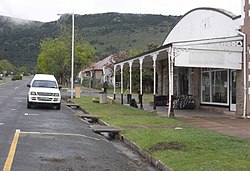Cathcart, Eastern Cape
| Cathcart | |
|---|---|

Main street in Cathcart
|
|
|
|
|
| Coordinates: 32°18′S 27°08′E / 32.300°S 27.133°ECoordinates: 32°18′S 27°08′E / 32.300°S 27.133°E | |
| Country | South Africa |
| Province | Eastern Cape |
| District | Amathole |
| Municipality | Amahlathi |
| Established | 1858 |
| Area | |
| • Total | 30.1 km2 (11.6 sq mi) |
| Population (2011) | |
| • Total | 7,360 |
| • Density | 240/km2 (630/sq mi) |
| Racial makeup (2011) | |
| • Black African | 93.4% |
| • Coloured | 2.0% |
| • Indian/Asian | 0.1% |
| • White | 4.3% |
| • Other | 0.2% |
| First languages (2011) | |
| • IsiXhosa | 90.6% |
| • English | 4.5% |
| • Afrikaans | 3.1% |
| • Other | 1.8% |
| Postal code (street) | 5310 |
| PO box | 5310 |
| Area code | 045 |
Cathcart is a town in the Eastern Cape province of South Africa, named after Sir George Cathcart, governor of the Cape of Good Hope 1852–1853.
The town is situated on the N6, just north of Stutterheim en route to Queenstown
Originally a small military post, established during the Eighth Frontier War, it was established as a village in 1858 when German colonists arrived in the region. Work on its railway connection to East London on the coast was begun by the Cape government of John Molteno in 1876 and the line was officially opened on 3 November 1879.
...
Wikipedia



